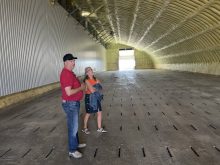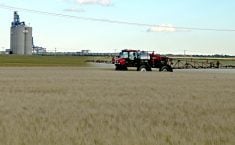ST. BENEDICT, Sask. – Last year this small town of 105 people, located an hour and a half drive east of Saskatoon, could have died.
The school was closed, the grain elevator shut down and the only coffee shop in town closed its doors along with the post office when the owner left town.
But in 1996, St. Benedict is thriving. Farmers still drive into town to get their mail along with a morning coffee in what used to be a classroom of the former school. In another room billiard balls clack across the felt surface of tables and this spring the gym and adjacent kitchen packed in 100 people on two occasions for dinner theatre productions.
Read Also

New coal mine proposal met with old concerns
A smaller version of the previously rejected Grassy Mountain coal mine project in Crowsnest Pass is back on the table, and the Livingstone Landowners Group continues to voice concerns about the environmental risks.
According to David Altrogge, the school has become St. Benedict’s mall.
He and five others volunteered on a committee set up in the spring of 1995 to decide what to do with the school building. They got approval to turn it into a community centre. A crucial factor was that 76 people, half of those at the meeting, agreed to help turn the school into a self-sufficient facility.
“I felt it was a real important point for the community to come together,” said Altrogge. “There’s lots of competition out there with people traveling to P.A.(Prince Albert) and Humboldt … (but) there was a strong sense of community present.”
Money needed for overhead
The community bought the school for $1 and set about the task of finding the $5,000 a year needed to keep the facility heated, clean and open.
A major draw for the building has been a coffee/postal shop set up by two local women. The shop has played a vital role in turning the building into a social spot so the community centre has become a familiar place that’s occupied every day, not an alien environment where people go for the occasional dance or wedding.
“Every day through the doors you have 50, 60 people pass,” said Altrogge.
Neither partner in the shop, Helen Martinka nor Joanne Shewchuk, had experience in running a coffee shop or postal outlet, and neither wanted to work full time, but Shewchuk said the venture has surpassed their expectations.
Fundraising efforts
Cheryl Lepsenyi, a former student at the school, organized the dinner theatre and is heading a tree planting project. A big map lying on a table in the entry way shows the plan to plant spruce, willows and lilacs on the grounds. There are also plans for a three-site campground in a corner of the old school grounds. For a $20 donation a tree will be planted in the donor’s name.
Walking through the halls of the facility, Lepsenyi points out the room rented by the billiards club, the meeting room and a museum with old class pictures where locals can laugh at themselves wearing bellbottoms, mini skirts with bright-colored tights and comic hair styles.
So far, 59 families have taken out a $20 annual membership in the facility. All the money the centre has raised has come from local residents without help from government grants.
St. Benedict is not the only community trying to find new uses for obsolete school buildings. Altrogge said Pilger now has a vehicle repair shop working out of its former school, while Alvena had a plastic mould business in its former school.
To Altrogge, the centre represents a renewal from the downward spiral affecting many rural areas.
“When my father was a young boy this place was twice as large and had two stores. Now I feel that there’s a resurgence of pride about living in a rural community.”
















